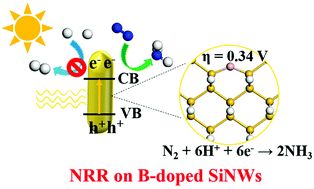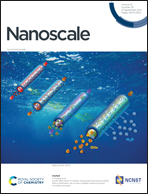p-Block element-doped silicon nanowires for nitrogen reduction reaction: a DFT study†
Abstract
Photocatalytic nitrogen reduction reaction (NRR) is a promising, green route to chemically reducing N2 into NH3 under ambient conditions, correlating to the N2 fixation process of nitrogenase enzymes. To achieve high-yield NRR with sunlight as the driving force, high-performance photocatalysts are essential. One-dimensional silicon nanowires (1D SiNWs) are a great photoelectric candidate, but inactive for NRR due to their inability to capture N2. In this study, we proposed SiNWs doped by p-block elements (B, C, P) to tune the affinity to N2 and demonstrated that two-coordinated boron (B2C) offers an ultra-low overpotential (η) of 0.34 V to catalyze full NRR, which is even much lower than that of flat benchmark Ru(0001) catalysts (η = 0.92 V). Moreover, aspects including suppressed hydrogen evolution reaction (HER), high-spin ground state of the B2C site, and decreased band gap after B-doping ensure the high selectivity and photocatalytic activity. Finally, this work not only shows the potential use of metal-free p-block element-based catalysts, but also would facilitate the development of 1D nanomaterials towards efficient reduction of N2 into NH3.



 Please wait while we load your content...
Please wait while we load your content...